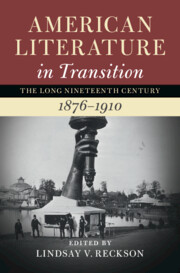Book contents
- American Literature in Transition, 1876–1910
- Nineteenth-Century American Literature in Transition
- American Literature in Transition, 1876–1910
- Copyright page
- Contents
- Contributors
- Series Preface
- Acknowledgments
- Chronology
- Introduction
- Part I Transitive States
- Chapter 1 Radical Pasts, Radical Futures
- Chapter 2 Unsettled Colonialisms
- Chapter 3 Secularism, Race, and Sex
- Chapter 4 Sex and the Suicide Plot
- Chapter 5 Virtual Subjects
- Part II Post-Reconstruction Aesthetics
- Part III Old Materialisms
- Part IV Immanent Techniques
- Index
Chapter 5 - Virtual Subjects
from Part I - Transitive States
Published online by Cambridge University Press: 24 August 2022
- American Literature in Transition, 1876–1910
- Nineteenth-Century American Literature in Transition
- American Literature in Transition, 1876–1910
- Copyright page
- Contents
- Contributors
- Series Preface
- Acknowledgments
- Chronology
- Introduction
- Part I Transitive States
- Chapter 1 Radical Pasts, Radical Futures
- Chapter 2 Unsettled Colonialisms
- Chapter 3 Secularism, Race, and Sex
- Chapter 4 Sex and the Suicide Plot
- Chapter 5 Virtual Subjects
- Part II Post-Reconstruction Aesthetics
- Part III Old Materialisms
- Part IV Immanent Techniques
- Index
Summary
I cannot help vanishing and disappearing and dissolving. It is my foremost trait.
— Stephen Crane, Letter to Ripley Hitchcock, 1896A psychologist cuts out a lobe of my brain … and then, when I find I cannot express myself, he says “you see, your faculty of language was localized in that lobe.” No doubt it was; and so, if he had filched my inkstand I should not have been able to continue my discussion until I had got another. Yea, the very thoughts would not come to me. So my faculty of discussion is equally localized in my inkstand.
— C. S. Peirce, 1905- Type
- Chapter
- Information
- American Literature in Transition, 1876–1910 , pp. 92 - 108Publisher: Cambridge University PressPrint publication year: 2022



